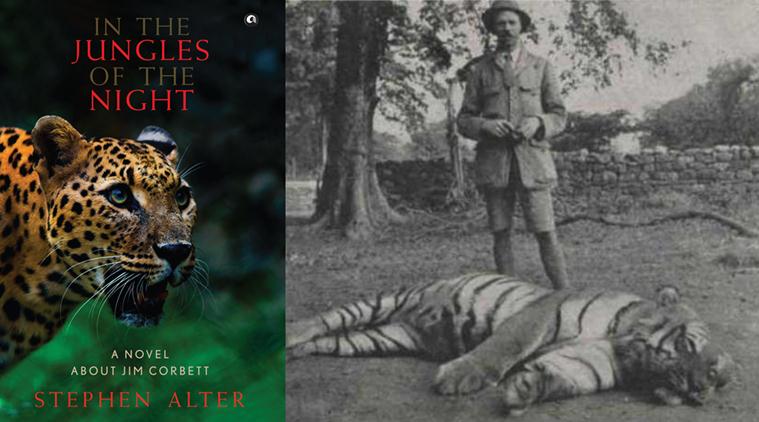- India
- International
The sensitive hunter: A book by Stephen Alter shows Jim Corbett in a new light
Stephen Alter tries to find out through his imagination, sketching three vignettes set in the youth, middle and towards the end of Corbett's life, drawing on "many of Corbett's stories and historical facts surrounding his life".
 Him Corbett is regarded as a conservationist who voiced the earliest warnings about India’s dwindling natural heritage. (Source: IANS)
Him Corbett is regarded as a conservationist who voiced the earliest warnings about India’s dwindling natural heritage. (Source: IANS)
In our era of threatened natural environment and diminishing wildlife, big-game hunters, leave alone poachers, are viewed with much opprobrium (remember the disgraced US hunter of Cecil the Lion?) but there are a few honourable exceptions. Especially, this accomplished hunter in the waning days of the Raj who killed to protect people – and was a Sahab like few others.
One of the few Englishmen still remembered with respect, gratitude and even awe in India, Jim Corbett’s exploits across the jungles in the Himalayan foothills of north India in the early 20th century are famous from his half a dozen odd engaging and evocative accounts.
But despite these, which also contain his affectionate impressions of a country where his Irish-origin family had lived for generations and whose common people he well understood, and a number of detailed biographies, there are still unanswered questions about his eventful, and enigmatic, life.
As this book asks: “Who was the real Jim Corbett?”
We know James Edward ‘Jim’ Corbett (1875-1955) was a “hunter who tracked down marauding tigers and leopards. A naturalist who spoke the language of the jungle. One of the first wildlife photographers to capture images of large predators in their natural habitat. A conservationist who voiced the earliest warnings about India’s dwindling natural heritage. A legend whose knowledge of the forests of India and the birds and animals that he encountered was unsurpassed. His bestselling books on shikar and jungle lore have inspired generations of wildlife enthusiasts”.
But was there more?

Stephen Alter tries to find out through his imagination, sketching three vignettes set in the youth, middle and towards the end of Corbett’s life, drawing on “many of Corbett’s stories and historical facts surrounding his life” but stressing it is “a work of fiction and does not aspire to any pretence of biographical surety”.
The Indian-born and bred American author, whose works include account of travels along the Ganga and in Pakistan, a biography of the Indian elephant and making of Bollywood classic “Omkara” besides some fiction, begins with “The Fern-Collector”, set in Nainital in 1888.
An atmospheric, initially eerie, account sees the teenaged Corbett, collecting botanical specimens in a graveyard, chance on a dug-up grave with the body it contained – of a young girl who had died a decade ago and attracted some rumours – missing.
As he participates enthusiastically in the police investigation and even helps to solve the mystery, we also learn about his background, and his growing interest in nature, fearlessness in penetrating the jungle and ascertaining his secrets, as well as his understanding and sympathy towards Indians.
It also is a tale of Victorian morality, class divides and – reminiscent of Joseph Conrad – the uncertain, unenviable fate of those who transgress the colonial, ‘civilisational ‘ norms, to go “beyond the pale”.
One inspired point is the presence, indirect though, of another writer who would subsequently also popularise Indian jungles and wildlife, and also present Indians sympathetically – Rudyard Kipling himself.
The “The Man-eater of Mayaghat”, set in the Kumaon along the Sarada river in 1926 , is the longest but also most true to type. The labourers brought into the area are huddled in the camp after a tigress preys on them, and Corbett brought in, finds it a complex mission.
Adding to the complications are an obnoxious forest officer, a mysterious girl living unafraid in the jungle, a Congress worker come to strive for the workers’ rights and a band of tribals. We also learn about Corbett’s World War I service and his modus operandi.
Finally, “Until the Day Break”, set in 1953 Kenya (where he had moved in 1947) soon after he hosted Princess Elizabeth and bade farewell to her as Queen, changes the narrative style from third person to first person as he ruminates over his life, its course and choices and why he had chosen to leave India.
Even those who have read the entire Corbett corpus and biographies, this will be a welcome read offering a new look into a hunter who never lost his sympathy for any living creature – except snakes – or wonder for nature.
Apr 19: Latest News
- 01
- 02
- 03
- 04
- 05


































